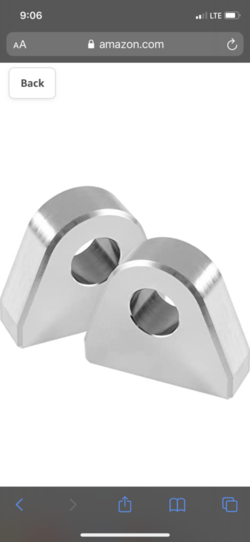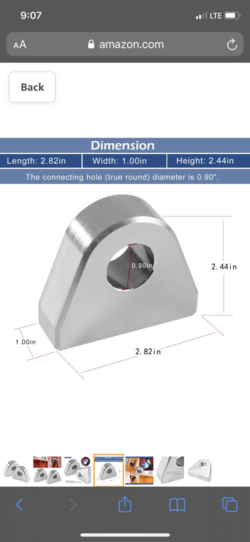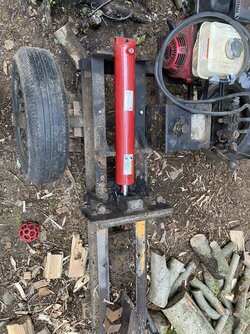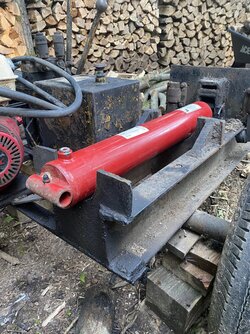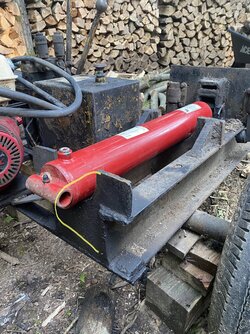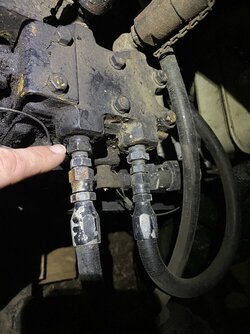4 way wedge on home build splitter
- Thread starter DonTee
- Start date
-
Active since 1995, Hearth.com is THE place on the internet for free information and advice about wood stoves, pellet stoves and other energy saving equipment.
We strive to provide opinions, articles, discussions and history related to Hearth Products and in a more general sense, energy issues.
We promote the EFFICIENT, RESPONSIBLE, CLEAN and SAFE use of all fuels, whether renewable or fossil.
You are using an out of date browser. It may not display this or other websites correctly.
You should upgrade or use an alternative browser.
You should upgrade or use an alternative browser.
Isaac Carlson
Minister of Fire
Wedge design is very important. Thin and sharp will split much easier than fat and dull. The difference just sharpness makes is amazing. The thin wedge requires a bit more movement in stringy wood, but it will go through just about anything.
Lol. Big wood pics. I only have small wood pics. But the wood is really long. That’s gotta count for something....
Ok, so let’s say end end labeled A mounts to
the splitter, and end labeled B mounts to the pusher. The B end should mount as it is to my pusher. The A end will need a bracket fabbed up.
So should I be looking for two pieces welded to the frame like the red bracket shown, or a complete bracket like the black one?
Looking at the pic of the cylinder, I’m thinking my spacing will have to be 3-4”. Can we use something like 1/4” steel for this? Thicker? And how the hell do you drill the 1” holes in that for the pin? Maybe my welding friend will know.
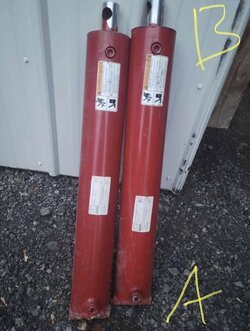
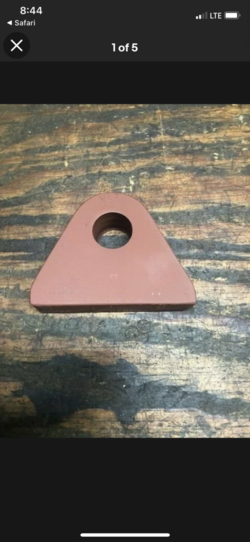
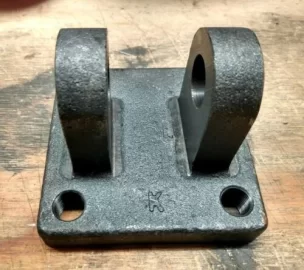
Ok, so let’s say end end labeled A mounts to
the splitter, and end labeled B mounts to the pusher. The B end should mount as it is to my pusher. The A end will need a bracket fabbed up.
So should I be looking for two pieces welded to the frame like the red bracket shown, or a complete bracket like the black one?
Looking at the pic of the cylinder, I’m thinking my spacing will have to be 3-4”. Can we use something like 1/4” steel for this? Thicker? And how the hell do you drill the 1” holes in that for the pin? Maybe my welding friend will know.



Ashful
Minister of Fire
I'd fab my own from something like the red plate you show, as it's going to be easier to adapt to your rig and cylinder. In fact, I'd just buy some flat stock, and cut what I needed from that with the chop saw or cutoff tool, unless you're lucky enough to have access to a mill.
You can drill 1" holes in 1/4" on a drill press, without too much trouble. Buy a 1/2" shank 1" twist bit, or even a stepped bit, not a huge deal. Use cutting oil, or any other oil you have, keep the speed low (300 - 600 RPM) and the bit cool. Keep the feed pressure up.
Your welder friend will already know this, but get everything drilled and fixtured in place, then tack weld only. Exercise everything, to make sure there are no interferences, binding, etc. Make any required adjustments, then remove the bits you care about to lay the final beads. Work alternating sides to lay the beads, so things don't pull to far out of position, checking as you go.
You can drill 1" holes in 1/4" on a drill press, without too much trouble. Buy a 1/2" shank 1" twist bit, or even a stepped bit, not a huge deal. Use cutting oil, or any other oil you have, keep the speed low (300 - 600 RPM) and the bit cool. Keep the feed pressure up.
Your welder friend will already know this, but get everything drilled and fixtured in place, then tack weld only. Exercise everything, to make sure there are no interferences, binding, etc. Make any required adjustments, then remove the bits you care about to lay the final beads. Work alternating sides to lay the beads, so things don't pull to far out of position, checking as you go.
Isaac Carlson
Minister of Fire
You could cut up to an inch off either side of the mounting tube if needed to make a narrower mount.
I picked up the cylinder today. Got it for a good price. It’s definitely a few years old, but looks to be unused.
Also I was looking at 1/4” steel at Lowe’s. Is that going to be thick enough? It just looked a little thin. Maybe double it up?
I’ll lay the cylinder on the splitter tomorrow and see what I’m working with as far as spacing.
Also I was looking at 1/4” steel at Lowe’s. Is that going to be thick enough? It just looked a little thin. Maybe double it up?
I’ll lay the cylinder on the splitter tomorrow and see what I’m working with as far as spacing.
brenndatomu
Minister of Fire
For splitting stringy stuff, a trick I seen is to fab up a "plate" to drop on the foot of the splitter (assuming its not a push through design) where the wedge can go "beyond contact"...basically a plate on either side of the wedge that takes up the foot to wedge gap, plus some...accomplished by hanging a spacer plate on both sides of the foot thick enough that that wedge can actually go between them...they can actually be made one piece by hanging both plates (sides) on the foot with a common bracket...if any of this makes sense? See if I can find pics...
brenndatomu
Minister of Fire
Ashful
Minister of Fire
I will confirm tomorrow, but looking at old photos, it looks like Speeco uses a single 3/4" plate to mount their 4" cylinder, at 22 tons:I picked up the cylinder today. Got it for a good price. It’s definitely a few years old, but looks to be unused.
Also I was looking at 1/4” steel at Lowe’s. Is that going to be thick enough? It just looked a little thin. Maybe double it up?
I’ll lay the cylinder on the splitter tomorrow and see what I’m working with as far as spacing.
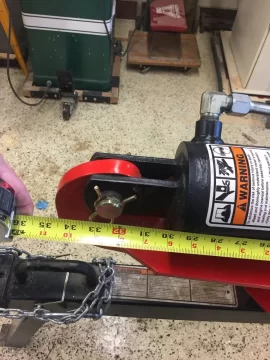
I will go out to the wood lot tomorrow and measure that mount plate and the cylinder tangs tomorrow, so you have a point of reference off a known-reliable setup of similar tonnage.
Isaac Carlson
Minister of Fire
I would think a 1/2" piece on either side would work. As long as it is tied in well and the welds are top notch, it should be good.
Does a spacer on the push-pad side, opposite wedge, accomplish the same thing? The block would take up the distance between wedge and ram so the stringy stuff gets split all the way through.I would think a 1/2" piece on either side would work. As long as it is tied in well and the welds are top notch, it should be good.
Ashful
Minister of Fire
I like that solution, brenndatomu. Mine is less technical.
I just throw an extra spit across the foot plate, when I run into something that requires overtravel. So, I end up with a dented split in the stack... no biggie.
I just throw an extra spit across the foot plate, when I run into something that requires overtravel. So, I end up with a dented split in the stack... no biggie.
Isaac Carlson
Minister of Fire
Yes. Vertical ears would work great. Remember to get the cylinder up off those chunks of steel. It looks like it will end up a couple inches higher once connected?
There is little/no need for a notched pusher. I was talking about the mounts when I mentioned half inch steel.
Extend the cylinder all the way and put the pusher about 1/4" from the wedge, then make and tack on your ears/mounts and give it a dry run to make sure it's good. If you have a piece stringy enough to give trouble with that setup, just put leave it and split another one. I run mine like a processor, with the splits staying on the wedge until the next round pushes them through. I drop a piece on, extend, retract, drop a round on, extend, etc... I got a bad case of tennis elbow from tossing splits into a pile and that convinced me to point the splitter where I want the wood and let it pile up. I might make a small chute on the splitter to get the splits a few feet further forward before they drop.
There is little/no need for a notched pusher. I was talking about the mounts when I mentioned half inch steel.
Extend the cylinder all the way and put the pusher about 1/4" from the wedge, then make and tack on your ears/mounts and give it a dry run to make sure it's good. If you have a piece stringy enough to give trouble with that setup, just put leave it and split another one. I run mine like a processor, with the splits staying on the wedge until the next round pushes them through. I drop a piece on, extend, retract, drop a round on, extend, etc... I got a bad case of tennis elbow from tossing splits into a pile and that convinced me to point the splitter where I want the wood and let it pile up. I might make a small chute on the splitter to get the splits a few feet further forward before they drop.
When I put the pin in on the pusher side it will bring the cylinder up about an inch over the old brackets. I think it should be enough wiggle room for it.
I have a theory.... I got a bad case of tennis elbow from tossing splits into a pile and that convinced me to point the splitter where I want the wood and let it pile up. I might make a small chute on the splitter to get the splits a few feet further forward before they drop.
don't handle the wood more than absolutely necessary...
so when i am splitting, the split wood doesn't fall where you have to bend over and pick it up AGAIN...
So as i am splitting once the wood is split i take the split pieces and stack them as they are already in my hands and at waist level.
The last month i have been nursing a bad left shoulder,my wood cutting routine has continued.With my way of processing wood having a bad shoulder hasn't slowed it down much.I can take one split and place it in my left arm to carry it while the right does the moving around.Only 4 cords to go to fill the shed.
I usually stack as I split if splitting by hand. Or split into a pile if using the hyd splitter.
The ports on my old cylinder were 1/2”. The ones on the new cylinder are supposed to be 1/2” also, but they measure 3/4”. So I guess I need to get some 3/4” to 1/2” reducers so my existing hoses will fit on there.
I think those are just called 3/4” NPT to 1/2” flare fittings right?
I think those are just called 3/4” NPT to 1/2” flare fittings right?
brenndatomu
Minister of Fire
1/2" NPT measures about 3/4" OD...is that what you are checking?The ports on my old cylinder were 1/2”. The ones on the new cylinder are supposed to be 1/2” also, but they measure 3/4”
Oh yeah I’m measuring OD. Whoops.
So the new cylinder does have 1/2” fittings. That means my old ones are smaller than that.
So the new cylinder does have 1/2” fittings. That means my old ones are smaller than that.
Isaac Carlson
Minister of Fire
brenndatomu
Minister of Fire
That's costing you some speed for sure! Each time you go up a size you roughly double flow rate.So looking at the pump on my splitter, they used reducers to go down from the 1/2” ports, to whatever is on there now. It’s around 1/4” ID.
If at some point I replaced the lines and fittings with 1/2”, could I pick up any cycle speed?
View attachment 298874
Similar threads
- Replies
- 21
- Views
- 2K
- Replies
- 0
- Views
- 339
- Replies
- 2
- Views
- 1K


